
Today’s classic Cadillac is owned by Bryan Wood of Chicagoland, and a fellow member of The American Brougham Society. No, not the group with the guy with the VW with the standup hood ornament, the one run by “That Hartford Guy” who owns a 1961 Cadillac Sedan de Ville and 1977 Lincoln Continental Town Coupe. Which reminds me, I should write his cars up too. Well! Some other time. Today, let’s keep the digressions to a minimum, haha.
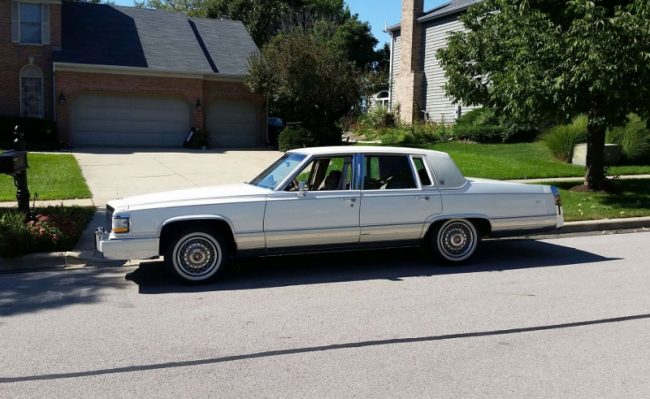
I know I’ve written up at least a couple of Broughams on these digital pages, but what can I say? I love these cars. When I was 10-11 I dreamed of owning one of these cars, not a 911 or Testarossa. I’ve always dearly loved giant Cadillacs, Lincolns and Chrysler New Yorkers. They’re so sumptuous, so chromed out. I just love seeing them.
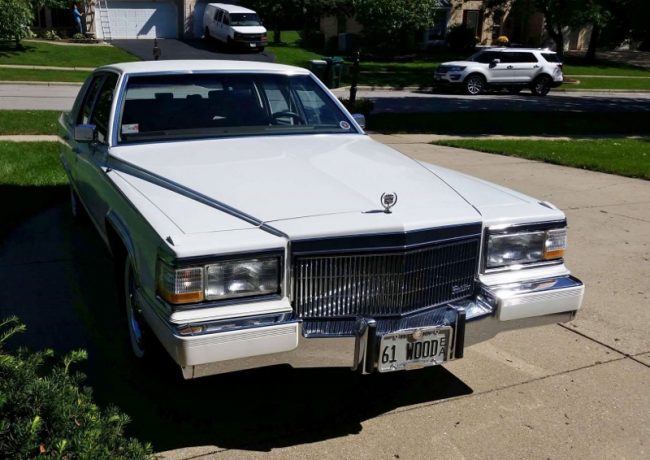
So here we go again. As previously mentioned, today’s car is owned by Bryan Wood. He told me a little about the car, as follows below:
“We bought the car 9 years ago from the original owners estate. It had 36,000 miles on it then. It has 44,800 on it now. Is 95 percent original. Wintered in Florida. Has won awards locally, at West of the Lake Chapter shows in Chicagoland, and awards the last 2 years at the Cadillac Fall Festival. Delivered new at Heritage Cadillac in Lombard.”
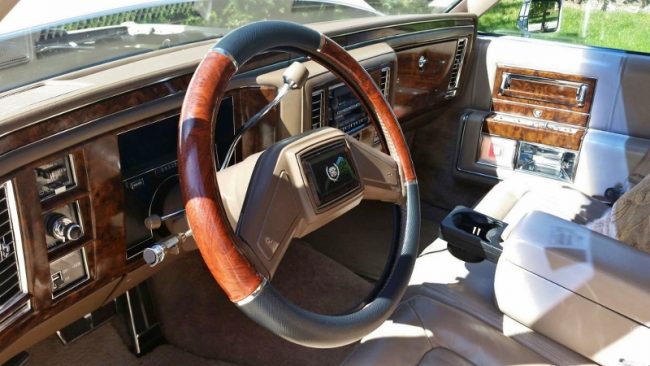
This car also has the optional 5.7 liter V8, with 185 horsepower. Now, that may sound a little low with today’s 300+ hp Impalas, but you have to factor in that old time classic V8 torque. No lunchbox-sized 2.0 liter turbo mills on these. No way! This car was delivered to its original owner by Heritage Cadillac on December 27th, 1989. Total price? $32,500.
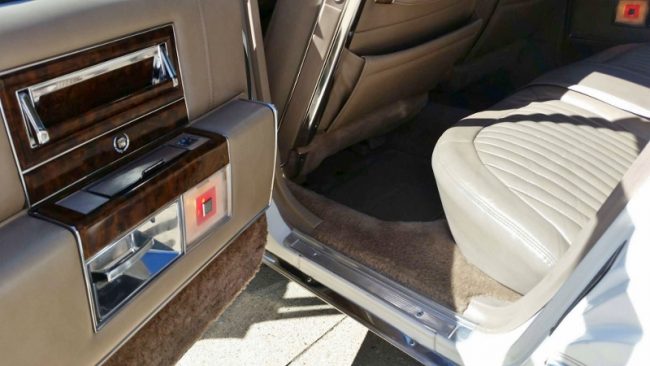
Not a bad deal for such an imposing luxury car. Let’s face it, this was no Lumina or Taurus! Finished in Cotillion White over Antelope leather interior, it cuts a striking figure in Chicago traffic, with all the me-too silver silvermist CR-Vs, Rogues and Altimas.
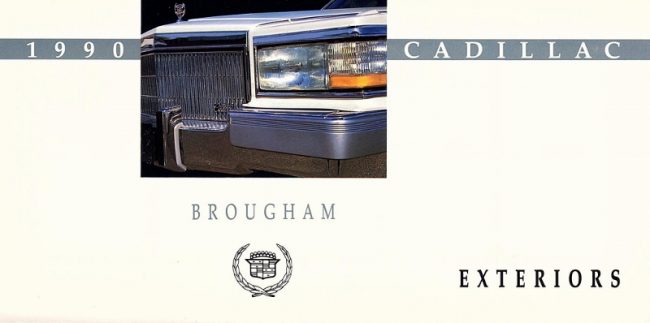
Color and trim was more plentiful than in The Year Of Our Lord 2019 as well. No jade green, sadly, but lovely blue and red hues, and Brownstone was rather compelling too.
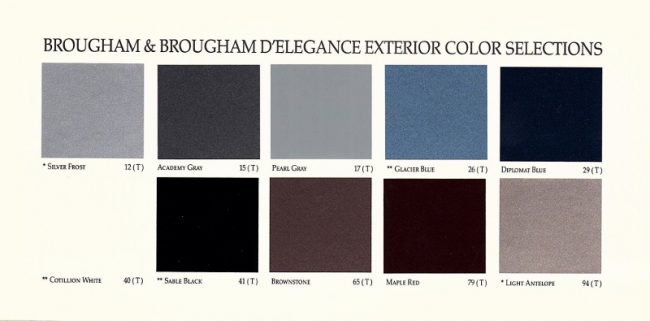
And how could you not love the red and navy interior color choices? I’ve always been fond of U.S. domestic-lux sedans in navy, dark green and burgundy.
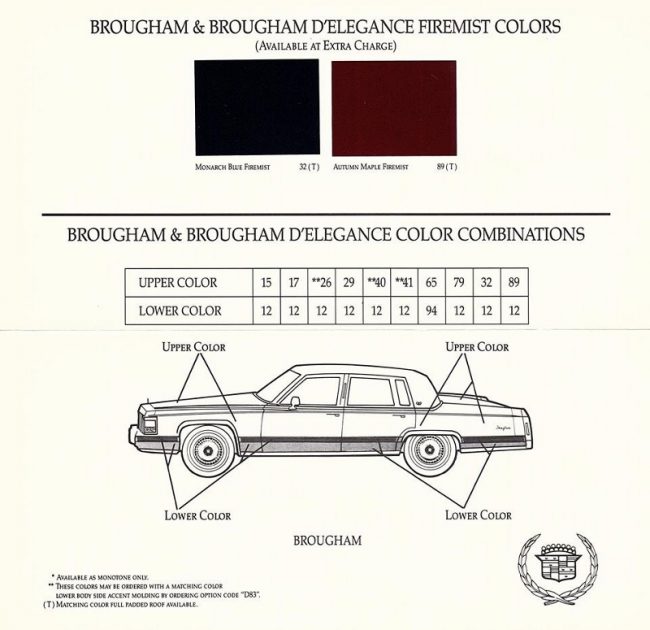
Classy colors for classy cars. Oh, and special thanks to my buddy Jayson Coombes for meticulously scanning his original Cadillac color charts for me!

Best of all, it’s a Cadillac. Classic styling, classic comfort and that good old V8 feeling. What’s not to like? I want one. Just need to get that three car garage…
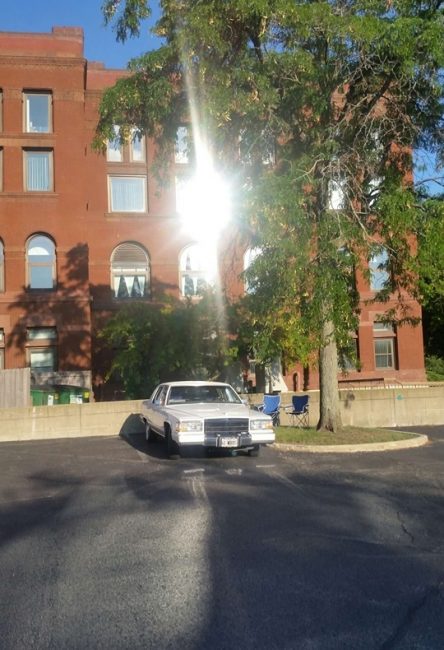







29 Comments
Nice car, but it also presents the conundrum that Cadillac was facing during that era in trying to keep old buyers happy while attracting younger import buyers. The new FWD stuff wasn’t attractive to many of the traditional Cadillac buyers who wanted size, pillow soft ride, and lots of chrome, so GM kept these around which meant this 1990 “traditional Cadillac” was little changed since 1977 and had arguably backslid in terms of losing the original clean styling and legitimate Cadillac engine. Thus this “grandpa” Cadillac was likely an embarrassment to the few import buyers who might otherwise have taken a look at the more modern Cadillac models, although those also had their own problems most notably the complete reliance on FWD, ohv motors, and too similar styling to Olds and Buick cousins. The reverence that many of the old-time Caddy buyers held their brand is reflected in the pristine condition of this specimen.
Many people post that the “the FWD cars weren’t popular with many Cadillac buyers” but the truth in the sales numbers shows that the FWD C-body cars far outsold these, granted after the 1985 there was no “cheaper” deVille series RWD car, and the 1989 “7th inning stretch” that the deVille and Fleetwood got, that got rid of the stubby “too small” look that the initial 1985 cars had further solidified the FWD C-body Cadillacs as solid sellers.
The downsized 1986 E/K cars were another story, but the FWD C’s were well received.
Carmine – you are correct that the FWD C-body Caddy sold pretty well, but they were losing the traditional “big car” market to Lincoln, which is why they kept on making the old RWD C-body. The problem with the FWD C-body was that it wasn’t attracting the BMW/Mercedes/Volvo/Lexus/Acura buyer, which not only cost Cadillac sales and profits, but also lost them cachet as the “it” brand for the rich and famous.
I don’t know how one or the other could lose “the traditional big car market” even if that was a smaller and smaller slice, since neither company ever stopped offering a big car during this time period. Lincoln kept selling a Town Car because, it was all it had pretty much, the Mark VII and LSC variants, even though they were much closer to what many think would be a “euro intended” luxury cars and even though they out-shined the 86 “baby-lac” Eldorados still never sold in huge numbers, neither did the pseudo Seville copy fox Continental.
Lincoln didn’t even have anything resembling a modern luxury sedan until the FWD Continental came out in 87-88 and that never ever came close to the numbers that the DeVille delivered for Cadillac.
I believe that Lincoln ran ads in both the late 1970s and mid 80s that pointed out only Lincoln was maintaining “traditional big car size and comfort” while Cadillac was downsizing. Of course the real reason for the campaign was Ford didn’t have money to modernize the Lincoln line-up to match Cadillac, but it was successful in maintaining or increasing Lincoln share even though their product-line was increasingly out-of-date during this period.
Not only did Lincoln run those ads, FORD ran them — for the LTD.
Ford ran them in 1977 for the LTD when the downsized GM cars came out, but it did little to fool buyers……
Imagine if the 1960 Cadillac flagship had been a 1947 Cadillac with an Oldsmobile engine. GM fans wouldn’t have been able to blame the Japanese for their demise.
The Brougham wasn’t the flagship, it was the biggest car in the line up, but it wasn’t the most expensive Cadillac anymore, the Allante, Fleetwood Sixty Special and the Seville STS were all more expensive than a Brougham, which hovered close to DeVille price, not saying that any of those other cars were stellar flagships either and I’m sure you’ll not waste an opportunity to shit all over them too, but I still wanted to point that out…….
Rather than Japanese (or European) competition, a bigger problem for GM in maintaining the Cadillac reputation for quality and innovation was the anti-trust threat that hung over them when GM had 50+% US market share. Imagine being told by top management to NOT increase market share because doing so would lead the Feds to break GM up, and then looking at investment decisions regarding expensive new technologies, products, and quality improvements, especially when Cadillac was better or equal to Lincoln and Imperial by most metrics throughout the 1950s to 1970s. Under such conditions, it was fully logical (and profit enhancing) to swap out Cadillac engines for cheaper Olds units, and not freshen up chassis and styling as frequently, and introduce new technology such as fuel injection, disk brakes, unit bodies, and independent rear suspensions more slowly. Of course such lethargy (together with 1970s fuel crises) created nice market openings for more advanced and better built foreign competitors, but they weren’t even on GM management radar until after the bean counters had completely taken over the GM culture from the engineers that had made them great.
Just a thought, but why didn’t GM react to pressure to stop increasing volume by moving some of their cars upmarket? When GM was at its peak, Mercedes-Benz was starting to make the presence of its S-class cars felt at the top of the market. Couldn’t GM have traded a few Chevrolet units for a few cars in the same price range as the coach-uilt 1957-1960 Eldorado Brougham? Those cars weren’t disposable luxury, and they weren’t selling by undercutting cars from the UK and Europe. When ‘voluntary import restraints’ hit the Japanese, they reacted by decimating Oldsmobile and Buick. Why didn’t GM go upmarket when their market share growth was capped? I think it is pretty telling that Toyota responded to the cap by making cars that commanded higher prices while GM tried to slow sales by building garbage.
CJ – beancounters almost always prefer to cut their way to prosperity rather than invest their way to prosperity. Thus their first instinct is to cut content and cost to make more profit from the same number of sales rather than make “risky” investments in better quality/technology and move product/brands upscale to command higher prices.
The division structure at GM also didn’t help, because Chevy and Pontiac managers wouldn’t want to voluntarily cut their low price volume and give it to upscale Buick and Cadillac, so instead you had Chevrolet and Pontiac going upscale by introducing fancy Caprices/Grandvilles, Monte Carlos/GPs, and upscale Blazers/Suburbans/Pickups that directly competed with Olds/Buick/Cadillac/GMC.
By the late 1980s/early 90s when GM finally decided to make some “upscale” experiments among their “prestige” brands with the Allante, Reatta, and Aurora, 30 years of beancounter management meant they nothing in their parts bin to create true competitors to the imports, and their brands had already lost all their cachet among younger buyers. After all, why would anyone in their right mind buy an Allante with a anemic pushrod V-8 for the same price as an MB SL, or a Reatta with a 1961 pushrod V-6 for the same price as large number of Japanese and European competitors with better technology and brand reputations, and what the hell is an Aurora? Meanwhile the leadership of Japanese and European automakers were/are coming from engineering, and not finance/accounting. Engineering is also where all GM upper-management (i.e. Sloan, Kettering, Knudsen, Cole, DeLorean) came from when they were working their way up to 50% market share.
The 1957-1958 Broughams were very impressive, but they were pretty problematic too, they were more of an “oh wow” vanity project of GM’s dick swinging from the era when it swung it best.
I look at that color chart and almost all are metallics. I’m sick of metallics. I see so many cars + SUVs that would stand out in a good way if some solid colors were used. By 1990 we were into metal flakes for at least 10 years.
Flakes were used to denote being special and luxurious. When everything is metallic then it is not that.
White + black don’t count as solid colors in my book.
Obviously, this type of car as a lot going for it. Presence, a smooth quiet ride, an engine that didn’t have to rely on high revs or gearing tricks to move this heavy car with authority. Yet at it’s core, it was trying to be reward for a job well done. The mostly male buyer was probably the sole family bread winner and marriage was still mostly for life. The pressure to stay in line and follow through must have been so enormous on those men. Cadillac understood that man and what he needed, respect and maybe a calming respite.
With the generation shift, responsibilities were out the window and everyone was just out for themselves. With the lack of purpose and direction came the depression. Now it was a brief display of aggression, fake mirages of power that passed for luxury. Driving could simulate the excitement of a video game. Cadillac will never be a leader in that game. That fact should enhance the prestige rather than subtract from it. Let the others build their AMGs and Hellcats and NISMOs and then look closely at the drivers of those sad expressions of a society gone wrong.
Just the opinion of someone who stayed in school, married and stayed married who was the sole family breadwinner for his offspring. Some still do it, more should, but where are their cars?
Enjoy reading your comments. My grandparents had these cars, and I grew up around them. As a young boy, I couldn’t figure out why they refused to upgrade their 80/81 his/hers brougham coupe/sedan until this came out, though in hindsight my grandfathers comments about gutless engines make more sense.
At the same time, my uncle got a Lexus ls400, which was quieter, faster, smoother, and better riding. But it did lack the style/presence of the Brougham.
I’m curious from reading your comments. It seems like your ideal car is something large with a stately/imposing presence that earns respect, smooth ride, high level of comfort/refinement with lots of torque. Does that about sum it up?
Pretty much. It may seem odd though. I do very much respect the FWD 85-88 Deville and 86-91 Seville/Eldo that many that might otherwise agree with me think are a bridge too far. With careful engineering and a new light weight V8 Caddy managed to provide the traditional experience in a package under 200 inches. It had added things like rack and pinion steering and an independent rear suspension but did so in a way that didn’t detract from the owner experience. What an engineering challenge. Naturally these cars annoy import fans even more. It was easy to say American cars were big and wasteful and therefore I want foreign. Understandable, but now they must concoct stories of quality or claim giant institutional incompetence of the Roger and Me style.
The original LS400 was a nice car but quite derivative. A uniquely Japanese luxury sedan might have been interesting. What floats the boat of successful Japanese executive then at the top of his game? The Q45 showed that American import buyers did not want that. They wanted a Mercedes with the electrical system of a Corolla. Showed who really had the quality problem. Remember also that putting aside 1st year dumping, the LS400 cost over 50% more than a Caddy. Did the LS400 have a quiet advantage commensurate?
John, I won’t disagree that the LS400 was in many ways a boring derivative design, but your criticism could also apply to the FWD C-Body and E-Body as they attempted to recreate the formal look of the longer RWD Cadillacs on a much shorter body, which was aesthetically not very attractive until they added some length in 1989. Arguably the transverse V-8 FWD drivetrain (with gobs of torque steer) was a greater leap for Cadillac than the RWD Lexus was for Toyota, but the creating a clean-sheet OHV (cast-iron head) V-8 for a “premium” brand in the 1980s was pretty derivative compared to the all alloy 32 valve DOHC Lexus and Infiniti. And there was certainly nothing innovative about the Cadillac interiors of that FWD era as they aped the fake wood and plastic chrome of the 1970s land yachts rather than offering something innovative (such as the electro-luminescent instruments of the Lexus) or at least old school quality (i.e. real wood trim).
Yes you can argue that the FWD Cadillac offered more car for the money than the LS, and they did sell pretty well, but they also did nothing to restore the luster to the Cadillac brand or attract the import buyer. In contrast, Toyota knew they had to overachieve to build up their Lexus brand, and the LS was created to be a bargain S-Class with similar technology/performance/luxury (and better reliability), while the FWD C-body Cadillac was simply an expensive Buick.
Real wood trim returned for the first time since 1969 in 1986 on the E/K cars and on the FWD Fleetwoods.
“but the creating a clean-sheet OHV (cast-iron head) V-8 for a “premium” brand in the 1980s”
The transverse V8s were not a “clean-sheet” design. They were derivatives of the HT4100 from 1982, which is many years before any Lexus or Infiniti was built and during a time when OHV luxury cars were plenty common.
You are being critical of Cadillac for failing to compete with cars that didn’t exist in the late 80s. The Q45 & LS400 came out in MY’90, the aero-body Cadillacs came out in MY’92 and the N* came out in MY’93 so it isn’t like GM sat around for 10 years resting on old-school laurels.
However, maybe GM would have been better off laurel-restingbecause I expect that the N* and aero-body cars ended many more customer relationships than any of the ’86-’91 FWD ones ever did.
I think there is a presumption that the DOHC multivalve layout is always an improvement. It is not always preferable to trade extra horsepower over 5000 rpm in exchange for less torque down low. This may have some resonance in a light sport coupe. For example where Fiat subbed a twin cam four in the sport coupe while the sedan had pushrods. Or when Honda added VTEC to the light Civic Si.
Think though how many cases where such changes have just blown up in the manufacturers faces. At Chrysler when the 40 horsepower greater 2.7 replaced the 3.3 pushrod in the Intrepid. When the 4.6 replaced the 5.0 in the Mustang. When the 3.7 V6 replaced the 4.0 in Jeeps. When the Shortstar replaced the 3.8 in Intriques. The 3.6 Jaguar replacing the 4.2 in the XJ6. In Japanese cars when the heavier front drive Celica tried to get by with a 97hp 2.0 Yamaha engine where there was a 2.4 in the previous year. When Toyota had just nothing decent for midsize trucks.The spreadsheets would have argued all those changes would have worked out great but t in real world driving not so much. Think for instance how much better the two GTI engine Audi V8 would have been if they had the vision to use the 2 valve version that actually had torque.
Torque steer at full throttle was an issue with the FWD V8 that no one else offered. Or course it still wasn’t blowing up the way you might expect if they also were not also pioneering super strong CV joints that seem to baffle lesser engineers. This doesn’t include the work in traction control that the torque steer was mitigated by it in a car that never needs full throttle anyway, as per tradition. It still raised it high over Chryslers, Lincolns, Audis, and Acuras with their compromised 90 degree V6s.
John – OHC is not necessarily superior for smooth “effortless” power desired in a luxury car, but in the minds of import buyers of the 1970s on it was deemed an indicator of technological superiority. In fact, if smooth effortless power was the only criteria, then Packard would still be around making 9 main bearing flathead straight eights, which were the smoothest luxury car engine ever made from my experience. Certainly there have been some disaster OHC engines by Audi and some others (including Cadillac), but the pushrod HT4100 also had some serious teething problems so reliability and durability is more about the testing and manufacturing quality than valve configuration, as the DOHC Lexus V-8 has been bulletproof from day 1.
I think the original LS400 was in the 35k range, not far off from a brougham, and then crept up into the low 40s as the value of the yen dropped. It was also much faster with a much more solid chassis, in addition to quieter.
Since you mention the e-bodies, I did like the 91 ETC as a kid simply because it was unique for a Cadillac. My first car was a final gen ETC. I’d call the 86-91 models a failure for not delivering what it’s traditional customers wanted: style. That’s the biggest failure of those cars, not the platform.
Btw, there is a car that fulfills all your requirements and is still being built today: Mercedes S-Class. Cadillac decided to exit that market but that’s really what it should be building today, if you look at the company’s history and traditional positioning. Oh well.
On the e body Eldo, lot of style added in 1988 without resorting to troweling on the weight like the Toro and Riviera did in their midlifes. The V8 was also gaining power faster than the 3800 in those. I would have like to have seen the graphic control centers make it into the Cadillac though. Way ahead of it’s time and annoyed all the right people. Honda clearly loved it, with the dimestore derivative they put in the 92 Prelude.
The best mainstream luxury today is the Volvo S90/V90. I drive a T5 Inscription. The inscription on those is important because it far upgrades the interior while avoiding the blackout wheels/grill that cost so much dignity. The T5 avoids the overly souped up super and turbo charged 2.0 and the heavy AWD. No V8 though, no designer today would have the vision to suggest a say 3.5L V8 that wouldn’t need to be mounted in a box or cycle through so many gears to hide how bad it’s manners are. All cars are international but at least the Swedish designers and assemblers in my cars case don’t obviously loath the traditions of the brand the way you see on modern Cadillacs, Jaguars, and Lexus. When mine was built in 2017, it was the only car that had added a standard autopilot system to lessen the stresses of long highway drives, just the kind of thing that the Cadillacs of yesteryear would have innovated. It is not a great time for luxury with Germany building for China instead of their own people and pretty much everyone else just scraping by on cars.
On LS400, by 1994 Deville, new that year $32,990, the Fleetwood, LT1 new that year $33,990, the LS400, still the basic 1990 $49,990.
John – low price was a problem with Cadillac. They shouldn’t have been priced to compete with Acura, Buick, Lincoln, and Volvo, but instead as the luxury division of the world’s largest car maker should have at least had some true flagship models that were technological equals (or better) than the LS400, S-Class, or 7 series and priced to match.
Stingray, there was no ability to raise or even maintain prices when so much Japanese production was being invited in during a recession. Even the LS400 sales dropped in half between 90 and 94 as the extent to which they were dumping them lessened. The politicos were sure asleep at the switch to have allowed that. As they always seemed to be in the USA and UK.
I never really liked the ’90 facelift although the FI chevy engines are nice upgrade over what was previously available.
Still, I think I’d have to go with any pre-1990 nondiesel/non HT4100 or a ’94-’96.
To John above,
Got to say I agree with stingray65. Real luxury cars do not promote themselves as best value. That’s supposedly what GM has Buick for. Cadillac is supposed to compete head to head with the best, no excuses.
Volvo V90 is a nice ride with pretty interior. You do realize it’s owned by a Chinese company, no? A bit ironic, given your complaint of automakers catering to China? Either way, it’s a 5-series competitor, not a 7, like a traditional flagship Cadillac is supposed to be.